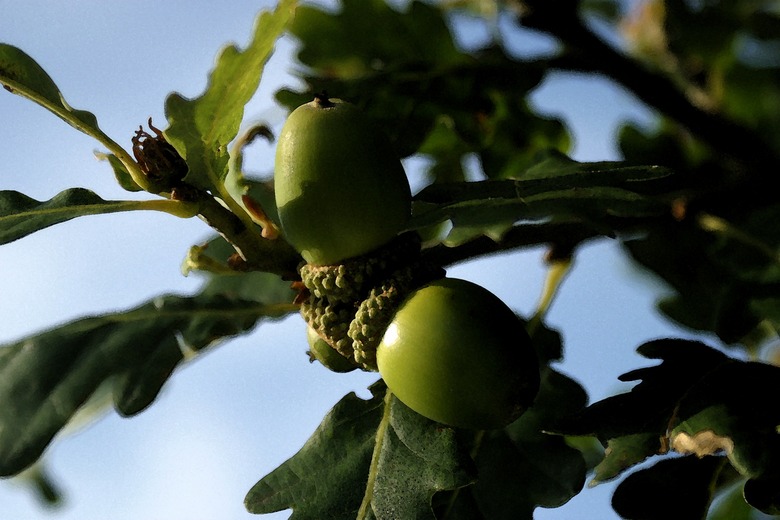Are Acorns Bad For My Grass?
Acorns aren't bad for lawns and turf grass. They also aren't particularly good. Left in place for a long period, an acorn will usually shade-out the grass growing directly beneath it, leaving a bald spot — the worst damage acorns cause directly. It's fine to leave acorns in place, given that most homeowners will eventually grind them up with the lawnmower. But you can also remove them and put them to good use elsewhere.
Leave
A few bare spots on the lawn aren't usually a problem. Hundreds and hundreds of them become unsightly, however, and offer weeds an opening. More irritating to many homeowners are the squirrels and chipmunks acorns invite. If they cache even some of their acorns in your lawn, the lawn holes get much bigger, and may continue for years, as squirrels keep coming back to dig and look for the food they stored somewhere under your grass. Routine mowing will chop up most of your acorns — eventually. Mow down or pull by hand any acorns that sprout into tiny oaks.
- Acorns aren't bad for lawns and turf grass.
- It's fine to leave acorns in place, given that most homeowners will eventually grind them up with the lawnmower.
Remove
Many homeowners decide to remove acorns from their lawns, for various reasons, including the simple fact that lawns get lumpy and hard to walk on when the grass hides countless acorns. Raking is the time-honored solution. Vacuum them if you have a sophisticated mower. You can also hire an industrious neighborhood kid to pick them up. Store acorns in the garage or other cool dry place and set them out throughout the winter to feed wildlife.
Compost
Return acorn nutrients to the soil by composting or mulching them. Because acorns are hard shelled, smash them first to boost decomposition. Some people collect acorns in a burlap bag, toss the tied bag onto the driveway and then drive back and forth over the bag before adding acorn meats and shells to their regular "hot" compost pile. Another option is starting a separate "slow compost" bin or pile for acorns, along with conifer cones, nut shells, twigs and thick, glossy leaves. Or use smashed acorns as "bottom mulch" around oaks and other trees, adding pine straw or another more attractive mulch on top.
- Many homeowners decide to remove acorns from their lawns, for various reasons, including the simple fact that lawns get lumpy and hard to walk on when the grass hides countless acorns.
- Some people collect acorns in a burlap bag, toss the tied bag onto the driveway and then drive back and forth over the bag before adding acorn meats and shells to their regular "hot" compost pile.
Grow
You can also grow new oak trees as a family, classroom, 4-H, scouting or service club project, especially if they are native oaks that can be used in habitat restoration and ecosystem rehabilitation projects. Growing and planning native trees supports species diversity, provides food and shelter for wildlife and improves the environment. Oak trees also provide erosion control and timber, and take in and use carbon dioxide to create oxygen.
Cook
Equally educational is cooking and eating acorns, given that they are a dietary staple in many cultures, a rich source of complex carbohydrates and fats offering some good quality protein. Acorns contain bitter tannins, so you'll need to leach them out of the acorn "meat" in the process of turning it into a flourlike meal. This meal is tasty when blended with other flours for pancakes, breads and almost any dishes that call for cornmeal or masa. Some sample recipes are included in a Mother Earth News article (see Resources).
- You can also grow new oak trees as a family, classroom, 4-H, scouting or service club project, especially if they are native oaks that can be used in habitat restoration and ecosystem rehabilitation projects.
- Equally educational is cooking and eating acorns, given that they are a dietary staple in many cultures, a rich source of complex carbohydrates and fats offering some good quality protein.
